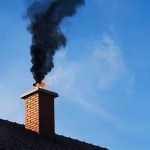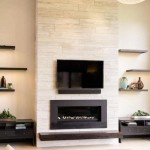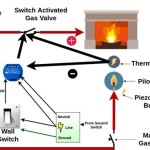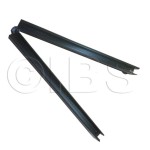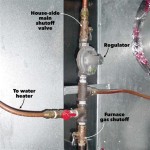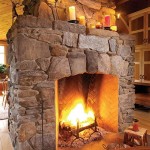Fireplace Mantle Heat Deflector Shield: Protecting Your Investment
A fireplace is a focal point in many homes, offering warmth and aesthetic appeal. However, the intense heat generated by a fireplace can pose a threat to the mantelpiece above, leading to damage over time. A fireplace mantle heat deflector shield is an accessory designed to mitigate this risk, protecting the mantel from excessive heat exposure and prolonging its lifespan.
The fundamental purpose of a heat deflector shield is to redirect heat emanating from the fireplace outwards and away from the mantle. This redirection prevents the direct and prolonged exposure of the mantle to high temperatures, which can cause warping, cracking, discoloration, and even combustion in extreme cases. These shields are typically constructed from materials resistant to high temperatures, such as steel, aluminum, or specialized heat-resistant composites. The design usually involves a slightly angled surface that forces rising heat to travel away from the mantel's underside.
The selection of a suitable fireplace mantle heat deflector shield depends on various factors, including the size and style of the fireplace opening, the distance between the fireplace opening and the mantle, the material of the mantle itself, and the desired aesthetic. Shields are available in different sizes and finishes to accommodate a wide range of fireplace and mantle designs. When making a selection, careful consideration should be given to the shield's dimensions to ensure that it effectively covers the area of the mantle that is most exposed to heat. The shield should also be visually complementary to the fireplace and mantle, maintaining the overall aesthetic appeal of the space.
Understanding the Benefits of a Heat Deflector Shield
The primary advantage of using a heat deflector shield is the protection it provides to the fireplace mantle. Without a shield, the wood comprising the mantle is continuously subjected to the direct heat rising from the fireplace. Over time, this can lead to a variety of problems. Wood can dry out and warp, causing structural damage and unsightly cracks. The finish on the mantle can also be affected, with the heat causing discoloration, blistering, or peeling. In extreme cases, especially with older or poorly maintained mantles, prolonged exposure to high heat can even pose a fire hazard.
By deflecting the heat away from the mantle, the shield significantly reduces the risk of these problems occurring. The mantle remains cooler, preventing warping, cracking, and finish damage. This, in turn, extends the lifespan of the mantle and preserves its aesthetic appearance. For homeowners with valuable or antique mantles, a heat deflector shield is an essential investment to protect their investment.
Beyond the direct protection of the mantle, a heat deflector shield can also contribute to improved energy efficiency. By redirecting heat outwards, it can help to distribute the heat more evenly throughout the room. This can result in a more comfortable and consistent temperature, reducing the need to constantly adjust the thermostat. In some cases, the redirected heat can even help to warm adjacent areas of the home.
Furthermore, a heat deflector shield can enhance fireplace safety. By preventing the mantle from overheating, it reduces the risk of fire hazards. This is particularly important in homes with older fireplaces that may not meet current safety standards. The shield also serves as a barrier, preventing flammable materials from accidentally coming into contact with the direct heat of the fire.
Factors to Consider When Choosing a Heat Deflector Shield
Selecting the right heat deflector shield requires careful consideration of several factors. First and foremost, the size of the shield must be appropriate for the fireplace opening and the mantle. The shield should be wide enough to completely cover the area of the mantle that is directly exposed to heat. It should also be tall enough to effectively deflect the heat upwards and outwards, preventing it from reaching the mantle's underside. Measuring the fireplace opening and the mantle is crucial to ensure a proper fit.
The material of the shield is another important consideration. Steel and aluminum are common choices due to their durability and heat resistance. However, some shields are made from specialized heat-resistant composites that offer even better performance. The material should be able to withstand high temperatures without warping, cracking, or melting. The finish of the shield should also be considered, as it will affect the overall aesthetic of the fireplace. Shields are available in a variety of finishes, including black, bronze, and stainless steel, to complement different fireplace and mantle styles.
The installation method is also a key factor to consider. Some shields are designed to be easily installed by the homeowner, while others may require professional installation. The installation method should be secure and stable, ensuring that the shield remains in place even during periods of intense heat. Some shields are attached to the fireplace using magnets or screws, while others are simply placed on top of the fireplace opening. The chosen installation method should be compatible with the fireplace and mantle, and it should not damage either structure.
Finally, the cost of the shield is a consideration. Heat deflector shields range in price from relatively inexpensive to quite expensive, depending on the size, material, and finish. It is important to balance the cost of the shield with its performance and aesthetic value. A more expensive shield may offer better heat protection and a more attractive appearance, but it may not be necessary for all fireplaces. Homeowners should carefully consider their needs and budget before making a purchase.
Installation and Maintenance of a Heat Deflector Shield
The installation process for a fireplace mantle heat deflector shield is generally straightforward, but it is essential to follow the manufacturer's instructions carefully to ensure proper installation and optimal performance. For shields that attach to the fireplace using magnets or screws, it is crucial to ensure that the attachment points are secure and stable. The shield should be positioned so that it effectively deflects heat away from the mantle without obstructing the fireplace opening.
For shields that simply rest on top of the fireplace opening, it is important to ensure that they are stable and level. The shield should be placed so that it covers the area of the mantle that is most exposed to heat. It may be necessary to adjust the position of the shield to achieve optimal heat deflection. In some cases, it may be helpful to use shims or other supports to ensure that the shield is level and stable.
Once the shield is installed, it is important to inspect it regularly for any signs of damage or wear. Check for warping, cracking, or discoloration of the shield material. Also, inspect the attachment points to ensure that they are still secure. If any damage is detected, the shield should be repaired or replaced immediately to prevent further damage to the mantle.
Cleaning the heat deflector shield is also an important part of maintenance. Over time, the shield can accumulate soot, dust, and other debris. This can reduce its effectiveness and detract from its appearance. The shield should be cleaned regularly using a mild detergent and a soft cloth. Avoid using harsh chemicals or abrasive cleaners, as these can damage the shield's finish. Before cleaning the shield, be sure to allow it to cool completely to avoid burns.
In addition to regular cleaning, it is also important to inspect the fireplace and chimney for any signs of problems. A buildup of soot or creosote in the chimney can increase the risk of a chimney fire, which can damage the fireplace and mantle. Regular chimney inspections and cleanings are essential to ensure the safe and efficient operation of the fireplace.
By following these installation and maintenance guidelines, homeowners can ensure that their fireplace mantle heat deflector shield provides effective protection and prolongs the lifespan of their mantle. A well-maintained shield will not only protect the mantle from heat damage but also enhance the overall aesthetic appeal and safety of the fireplace.

Fireplace Hood Canopy Or Heat Deflector Project Small House

How To Protect A Mantel

Mantel Shield 47 54110 Woodheatstoves Com

Mantleflect Shield

Any Of Mantle Heat Shield Hearth Com Forums Home

Fireplace Hoods Heat Deflectors Custom
Heat Shields Hearth Com Forums Home
Stainless Steel Heat Shield For Mantel Hearth Com Forums Home

Fireplace Hood Canopy Or Heat Deflector Project Small House

Fireplace Hood Canopy Or Heat Deflector Project Small House

